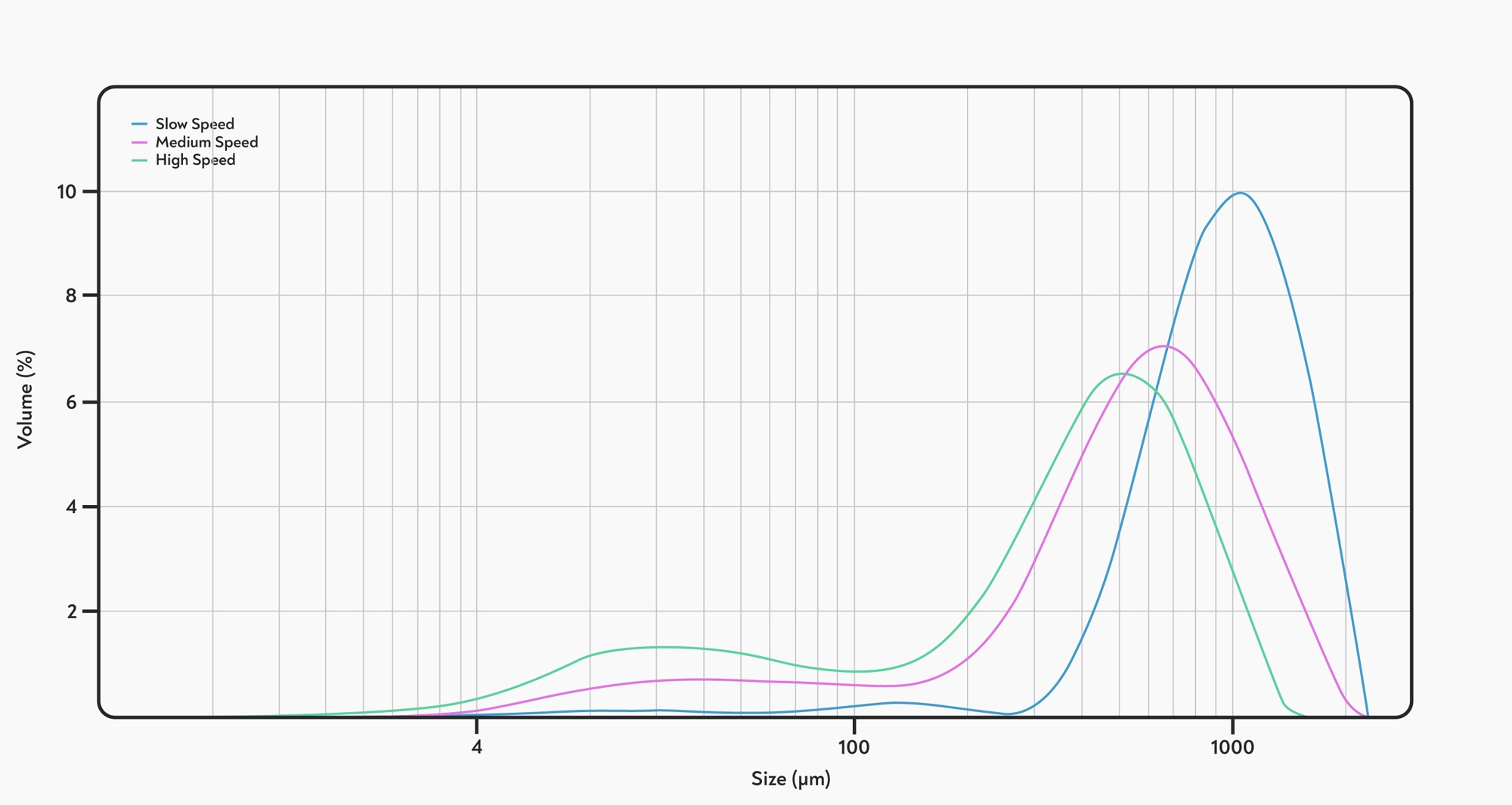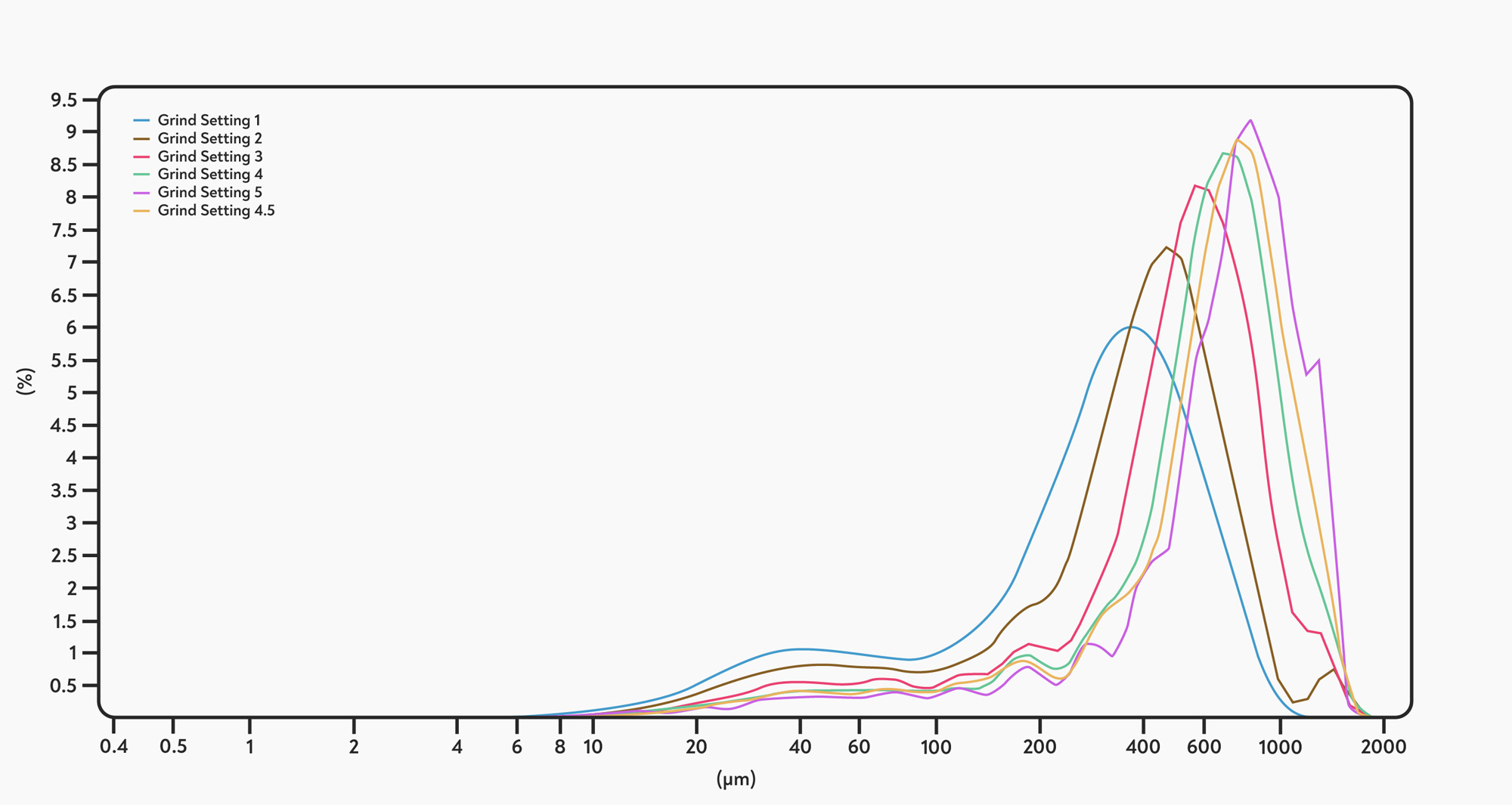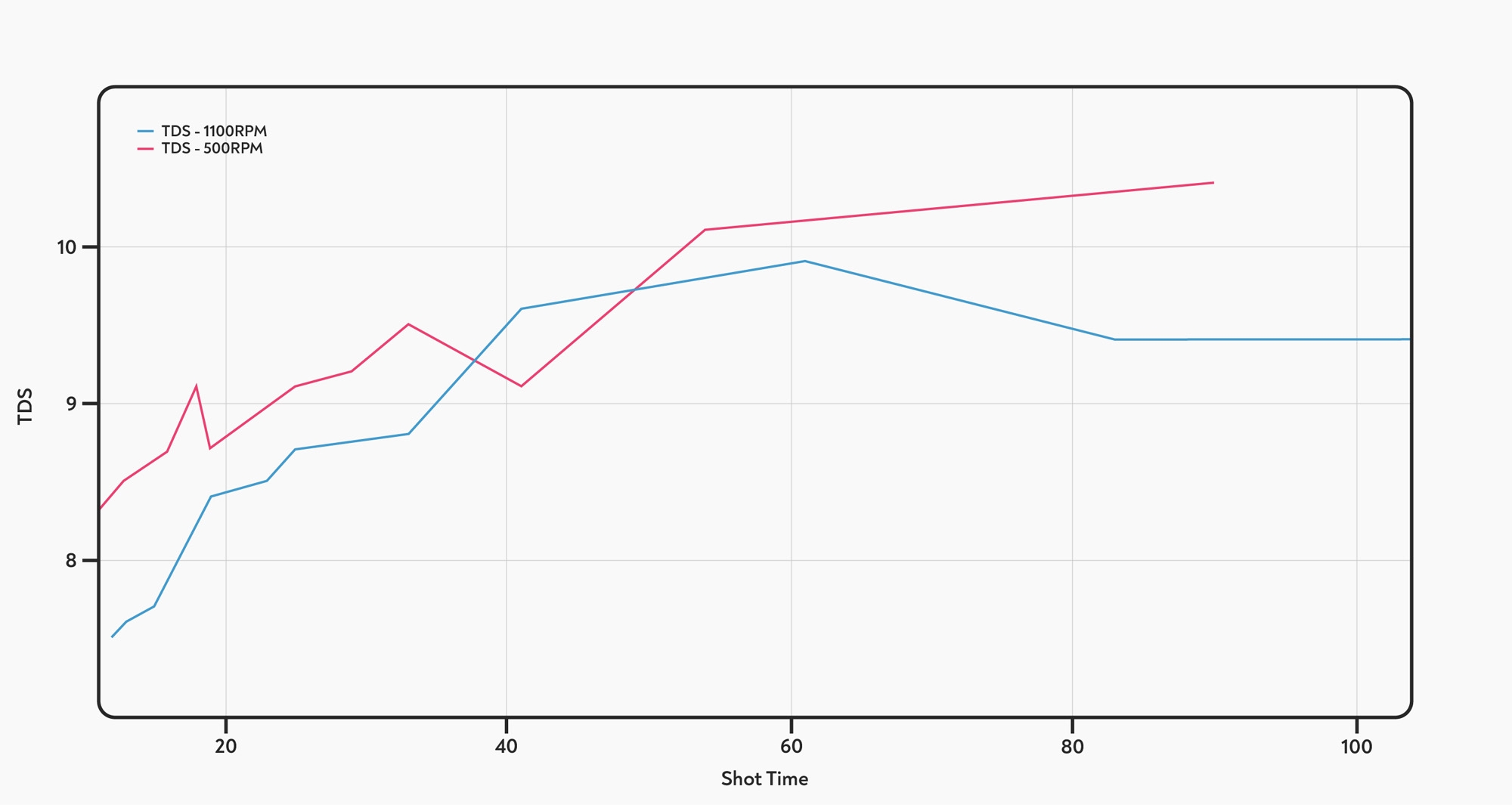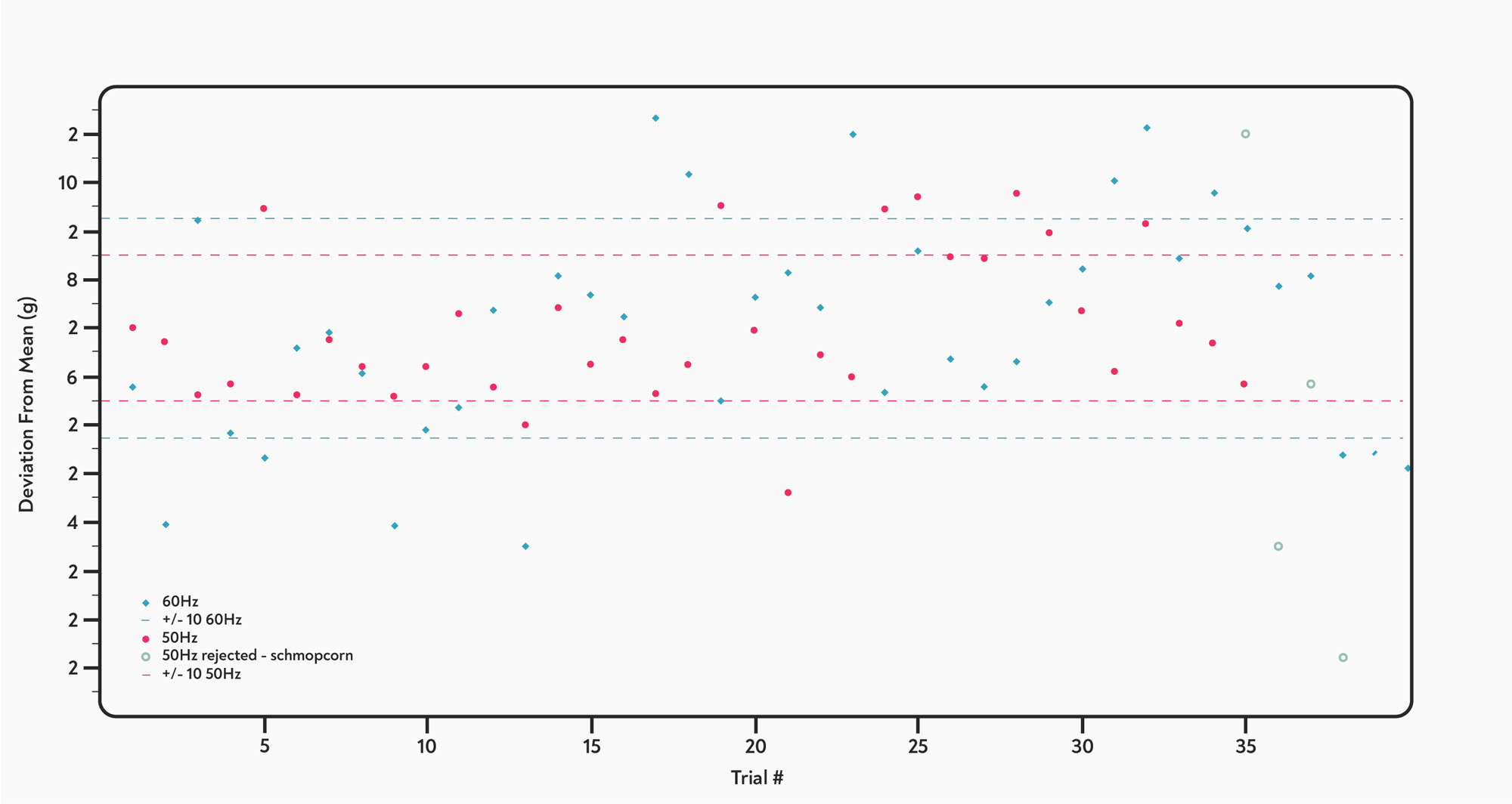How does it change the performance?
In the last few years, a small number of grinders have hit the market that boast an adjustable grinding speed. The best known of these are Lynn Weber’s EG-1, Victoria Arduino’s Mythos 2, and most recently Ceado’s Hero E37Z. The marketing material for each of these grinders claims that being able to change the RPM allows you to somehow optimise the grind for different coffees, or produce different types of extraction — but none of them make any specific claims about how slower or faster grind speeds might achieve this. So is the adjustable RPM just a gimmick, or can it really improve our extractions?
Grind Size Distribution
The holy grail of coffee grinding is to produce higher, more even extractions, by producing particles that are more even in size. Unfortunately, the published evidence for the effect of RPM on the particle size distribution is limited, and the effect may well be different for different grinders.
What we can say is that faster RPMs typically deliver finer grinds for a given إعداد الطحن, producing more الطحن الناعم and a less modal توزيع حجم الطحن. However, it’s not yet clear if this effect is any different to simply grinding finer.
 Particle size distributions of coffee ground at different RPMs. Source: Blackwater Issue
Particle size distributions of coffee ground at different RPMs. Source: Blackwater Issue
This chart, adapted from an article in Korea’s Blackwater Issue, shows the توزيع حجم الطحن changing as the burr speed changes, with the higher RPM resulting in a smaller median grind size and more الطحن الناعم. However, this effect appears to be very similar to the effects of simply changing the إعداد الطحن as shown in the graph below.
 Particle size distributions of coffee ground at different grind settings. Source: Blackwater Issue
Particle size distributions of coffee ground at different grind settings. Source: Blackwater Issue
Selecting a finer إعداد الطحن also results in a smaller median grind size and more الطحن الناعم. This difference appears to be fairly similar to the effect of increasing burr RPM.
These results are backed up by Jonathan Gagne’s experiments with his EG-1: “‘With my التروس, more speed makes the distribution finer and that’s it,” he explained in Matt’s Telegram Channel. “If I compensate with the spacing I get the exact same results in [extraction] and taste.”
الاستخلاص
We do however have one piece of evidence that changing the RPM changes extraction, beyond just making the grind finer. Gwilym Davies sent us some data from a series of shots he ran using a Mythos 2 at two different RPM settings. He also found that a higher RPM resulted in a finer grind and hence slower وقت تحضير الجرعات — but if you take the shot time into account, then the lower RPM setting produced consistently higher extractions.
 The effect of grinder RPM on the TDS of espresso shots. Grouping the data by shot time rather than إعداد الطحن shows a distinct difference in extraction between the two RPM settings. Data courtesy of Gwilym Davies
The effect of grinder RPM on the TDS of espresso shots. Grouping the data by shot time rather than إعداد الطحن shows a distinct difference in extraction between the two RPM settings. Data courtesy of Gwilym Davies
This shows that, for the Mythos 2 at least, changing the RPM is altering the grind quality beyond just making it finer or coarser. However, we can’t yet say if that’s because of changes to the particle size distribution, or some other factor — for example particle shape.
التحكم في حجم الجرعات
A higher RPM allows coffee to be ground more quickly, which might make the high RPM settings desirable in a busy cafe. However, grinding faster means the dose becomes less accurate. The Mythos 2 compensates for this by grinding the last portion of each dose more slowly, to increase the accuracy of the dosing.
This can have unexpected results in other grinders. AC motors use the alternating تردد of the current to turn the motor, which means that a different mains تردد will produce a different RPM. Most countries use a mains تردد of 50 Hz, but in the Americas, and some parts of Asia, 60 Hz is more common. This means a grinder with an AC motor operates at a higher rpm in the USA than it does in Australia, for example. This can make the dosing for this type of grinder slightly less accurate in the USA, and might have a small effect on grind quality, too.
 The effect of mains تردد (and hence RPM) on dosing. Source: Graeme Burton (@papamurgy)
The effect of mains تردد (and hence RPM) on dosing. Source: Graeme Burton (@papamurgy)
Heat
Finally, changing the RPM also changes the amount of heat produced in the grinder — but not in the way you might expect. In his talk at the 2015 Barista Camp, Christian Klatt explained that increasing the RPM of the grinder may actually reduce the effect of temperature on grinding. At higher rpm, the coffee passes through the grinder more quickly, so it has less time to absorb heat from the chamber, he explains. The motor will also generate less heat, as it is operating for less time per grind.




bravi. it’s the first time i see granulometric curves explained. also if my question, regarding the first graphic is: is by modifying the RPM from 400 micron i reach the 1000 micron, would’t it be better to compare the 2 curves coming out in the area 400 micron by adjusting the size but also augmenting the speed?
I hoe there will be the chance to explore this argoument more, we can provide malvern graphics since we have it at home. ciao.m
Some conclusions or summary would be nice. From what I get, when using a grinder like the EG-1, it seems there should be a sweet spot for each coffee, roast, and situation for what that particular extraction is being made for. At the same time, busy coffee bars would prefer fast grinders, so it stills needs to compare burr size related to RPM and how it affects particle size distribuition. How big burrs should be in order to grind fast, cold and reach extraction % similar to slower RPM on those 80mm burrs. Or maybe, even huge burrs are not exactly what’s needed. ¿?
This a little bit confusing. Which factor has the most affect or how can we manage and combine These factors together?
I think RPM is so important and we have to create a bunch of rules for manufacturing grinder and burrs and RPM.
Thanks for the great posts guys! I am a coffee lover and find your articles invaluable!